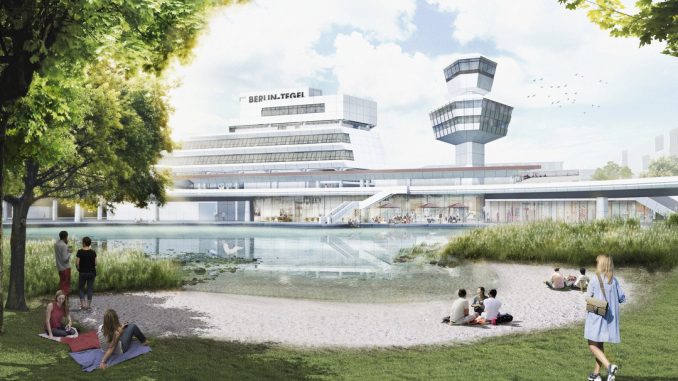


Image by Tegel Projekt and featured with permission
Tegel Airport, Berlin’s former primary international airport which opened in the Cold War and has since been decommissioned, will be getting new wings as a green neighborhood.
With the platform bowing out to a new international airport last year, the old Tegel Airport currently has 580 acres of unused space. It’s now being reconstructed as a carbon-neutral living and commercial zone called Schumacher Quartier, while preserving some qualities from its high-flying past. The project has been in the works since 2017.

Image by Tegel Projekt and featured with permission
The neighborhood is aimed at alleviating the housing shortage problem, encouraging green habits, as well as enriching the lives of its community. Residents will be able to travel to work, school, stores, daycare centers, and parks by foot or bike via its green walkways and bicycle lanes.

Image by Tegel Projekt and featured with permission
Schumacher Quartier will be mostly car-free, with a small exception for vehicles made for disabled individuals. Considering its previous life as an airport, this departure from emissions-heavy travel and arrival at cleaned-up pathways is notable.

Image by Tegel Projekt and featured with permission
More than 5,000 affordable homes will be built here, accommodating over 10,000 residents, with 4,000 more being planned for the neighborhood’s surroundings. Each abode will be constructed from locally-sourced wood, making Schumacher Quartier the longest cluster of mass timber buildings in the world. Through this, the Tegel Projekt, which is helming the overhaul, anticipates an 80% reduction in carbon footprint.
The hub’s rooftop gardens will collect rainwater, storing it to either be reused or to serve as “natural air-conditioning” when it evaporates during hot weather.

Image by Tegel Projekt and featured with permission
The neighborhood is being envisioned in a way where “the streets and squares belong to the people again,” the project’s press secretary Constanze Döll tells .

Image by Tegel Projekt and featured with permission
But it will also open up to other residents in nature. A large city park will help create a permanent habitat for 14 nearby endangered species, such as broad-wing bats and nightingale grasshoppers. Consequently, this would invite other species to settle into Schumacher Quartier too.

Image by Tegel Projekt and featured with permission
Harking back to its aviation roots, the neighborhood will reuse some of the old structures from the airport. The terminals, for instance, will be converted into tech offices and research labs.

Image by Tegel Projekt and featured with permission

Image by Tegel Projekt and featured with permission
The first campus is expected to be completed in 2027. At the moment, workers are clearing debris from the old airport grounds, including an airfield containing expired artillery shells from World War II.

Image by Tegel Projekt and featured with permission

Image by Tegel Projekt and featured with permission
[via
http://www.designtaxi.com/news/419919/Old-Berlin-Airport-Is-Transforming-Into-A-Climate-Friendly-Neighborhood/

Leave a Reply